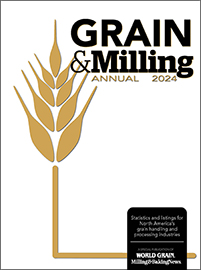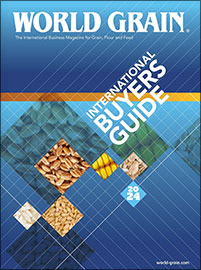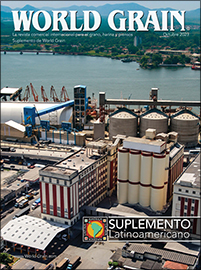ATLANTA, GEORGIA, US — With hundreds of exhibitors representing the breadth of the feed industry value chain on a busy expo floor, it’s easy to visualize the ripple effects of trade, ingredient safety and regulatory policy shifts amid a new US administration.
Constance Cullman, president and chief executive officer of the American Feed Industry Association (AFIA), said the association is poised to continue communicating the impact of decisions made in Washington, DC, and the International Production & Processing Expo (IPPE) is always an excellent opportunity to understand industry challenges and inform through education opportunities.
“So much is happening globally on the geopolitical stage, we just need to be cognizant that every action has an impact in some way on the supply chain,” Cullman said during an interview with World Grain at the IPPE in Atlanta, Georgia, US. “We’re such a finely tuned supply chain, and we will be doing a lot to communicate that to the (Trump) administration. The impacts and our understanding of those challenges are among the reasons that this show is so important.”
The 2025 IPPE at the Georgia World Congress Center has more than 597,900 square feet of exhibit space and features 1,380-plus exhibitors for thousands of attendees in the animal food, meat, and poultry and egg industries. The event is a collaboration of three trade shows — International Feed Expo, International Poultry Expo and International Meat Expo, and is sponsored by the AFIA, Meat Institute and US Poultry & Egg Association (USPOULTRY).
Cullman said that among the concerns for the AFIA and its membership is the resiliency of supply of vitamins and amino acids for animal food, as China is the major supplier of those to the United States. A potential disruption due to trade tensions could prove “catastrophic” for feed manufacturing.
“We are very concerned when we start talking about tariffs,” she said. “(We are) doing our best to communicate to the administration the importance of understanding the nuance of that relationship. So while we (the feed industry) would like to diversify our supply of vitamins and amino acids, we also acknowledge we can’t do that overnight.”
In concert with those supply concerns would be the major export and production markets of Canada and Mexico. Those countries are intertwined with the United States as part of a North American economy through the United States-Mexico-Canada Agreement (USMCA) trade agreement. Tariffs could interrupt sales, manufacturing and livestock processes that take place throughout the value chain, increasing costs in all three countries, Cullman noted.
The animal food industry also faces the prospect of a different regulatory atmosphere in a second Trump administration that follows four years of Democrat Joe Biden, who came to office after Trump’s first four-year term.
Cullman said the second Trump administration could be expected to focus on minimizing new regulations, evaluating current rules and taking a second look at those that were coming during the Biden administration.
Cullman noted a distinction between regulations that are meant to limit a business or entity and those that provide a license to operate. A key and ongoing goal of the AFIA is the review and modernization of regulations that address feed ingredients and their approval.
She said the Center for Veterinary Medicine at the US Food and Drug Administration (FDA) needs adequate funding to be able to review and assure the safety of animal food ingredients and products and complete the modernization of regulations in the United States.
“We’re advocating for regulation, but more science-based, more streamlined regulation, and we need the dollars to go with that for implementation,” Cullman said. “We want them (the administration and Congress) to think about not just cutting regulations, but modernizing them, make them more fit for their purpose.”
While the AFIA continues to look ahead on the political front, an outbreak of avian influenza has pushed into the national food conversation as well. Millions of chickens have been culled from flocks in an attempt to arrest the spread of the disease.
“It’s one of our No. 1 concerns when you ask what keeps us up at night,” Cullman said. “Biosecurity is and always has been very tight. We have biosecurity as part of our certification programs at AFIA. It’s always among the topics for education. We’re doing notices on a regular basis on bird flu and keeping our members informed.”
Educational opportunities on animal diseases, the latest technical innovations or regulations are part of what makes IPPE so valuable for the AFIA, Cullman said.
‘This is our premier networking event with our partners,” she said. “It’s really important for us to be here to help facilitate that business, and education is one of the reasons a lot of people come because they cannot only learn from our speakers and our programming and our materials, but they can learn from one another.”
Also busy sharing their insights and latest innovations were the equipment and technology suppliers on the expo floor of the Feed Hall. Cullman noted the impressive number of exhibitors was a sign of a diverse and strong feed industry.
Ag Growth International (AGI), based in Winnipeg, Manitoba, Canada, is continuing to showcase its complete feed mill solutions. The FLEXmill is a packaged precision feed blending system that offers an economical solution for on-farm or small capacity commercial feed manufacturing.
Noam Silberstein, AGI senior vice president, global feed, said customization and a need for flexibility remain key trends for feed manufacturers, and the FLEXmill is designed to go into existing infrastructure to provide a solution.
Shawn Conway, director, commercial execution and product transfer at AGI, said the age of current equipment and consolidation are driving these trends for feed manufacturers.
“With commodity prices that have been so high, they’re really looking for quality,” Conway said. “They’re trying to optimize what’s coming off the fields, change recipes and are really focused on the nutrition and the accuracy of the dosing.”
Another aspect is the need for technology automation across sensors, monitoring, data collection and insights, and the ability to do lights-out production, Silberstein said.
The FLEXmill, a model of which is on display at IPPE, includes a loop conveyor, hammermill, mixer and micro dosing station. AGI also can supply the storage and handling on the receiving end, and the truck load out.
“I think what differentiates us is the ability to offer that integrated solution,” Silberstein said. “We’re not just offering individual piece of equipment, though we can if that’s what the customer’s looking for. We’ll also do the entire solution from design engineering through to delivery of the full mill.”
For Bühler, Inc., Plymouth, Minnesota, US, retrofitting and modernizing existing feed operations has been an area of focus, said Chris Wagner, sales account representative-oilseeds, for Bühler.
“It’s a mature industry, so we don’t necessarily see a bunch of greenfield plants popping up,” he said. “What we’ve been focused on is retrofit capabilities, bringing older facilities up to modern day standards and efficiency.”
Bühler’s joint venture with Premier Tech is providing solutions for automated bagging and loadout systems tailored for the feed industry as well, said Wagner, who noted the shared exhibit space.
“We’re showcasing our partners here as part of being a full solutions provider,” he said.






